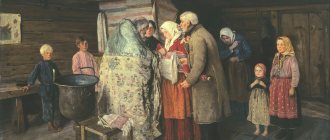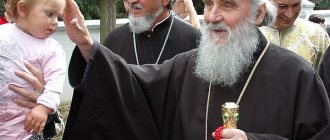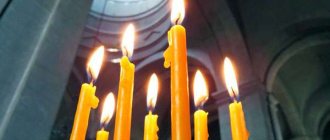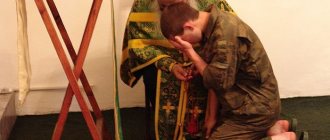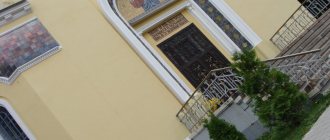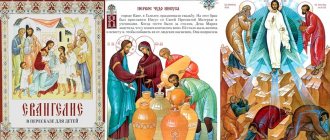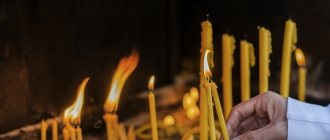The influence of holy places on the physical condition of a person
Since there is a problem on the site (blog) in terms of posting panoramic images (they are highly automatically compressed, as a result of which the image quality drops significantly), I decided to provide a link to the located file. By clicking on the photo you will be taken to the page where the original is located. Enjoy watching! “Floating over Moscow” “At the Moscow pier” “Donskoy Monastery (main entrance)” “Passing under the bridge” “Passing under the bridge” “In the Donskoy Monastery” “Pier on the Moscow River” “Cumulus clouds over the Moscow River” “ Geometry of the transition" "The road to the station" "At the fountain" "At the Kievsky station" "Kievsky station" "Tsaritsyno Park" "Tsaritsyno Park" "Church of the Ascension in the village of Kolomenskoye_2" "Church of the Ascension in the village of Kolomenskoye" "Roads-turns" “May contrasts” “Church of the Great Martyr George in the village of Kolomenskoye” “Paths of Tsaritsyno Park” “Living window on the evening sunset” “Excursion to Tsaritsyno” “On sharp turns” “Big Palace in Tsaritsyno” “The beauty of antiquity in the modern world (Kremlin in Izmailovo )" 17 years ago, on the site of the Kremlin and Vernissage in Izmailovo, known today throughout the world, there was an abandoned wasteland, lonelyly lurking behind the hotel complex. Once again, craftsmen came to this land, as in the 17th century, banged with hammers, axes, creaked with saws and built a miracle city with temple domes, fairground rows and carved gates. This is how the famous Kremlin in Izmailovo appeared, created on the basis of architectural motifs of the royal residence in Izmailovo. Since ancient times, the powerful fortress, the central part of the ancient Russian city, was called the Kremlin. The Kremlin was considered the core of the entire settlement. Its walls were the last possible barrier for enemies. The entire surviving population of the city gathered here for a “siege.” Initially, Kremlins were made of wood, but already in the 13th-14th centuries, in order to increase their defensive capability, architects began to erect stone outposts, impervious to fire, surrounded by impregnable towers and water ditches. In Russia there are more than 20 historical and cultural complexes, behind which the name “Kremlin” has firmly established itself. These are not only military fortresses with stone walls and towers, they are also wonderful architectural complexes with temples, palaces, chambers, and solemnly decorated entrances. The Kremlins of Russia are the pride of our Russian land. The Kremlin in Izmailovo combines many features of ancient Russian kremlins from different centuries. Within its walls, the Izmailovo Kremlin collected all the best that was in the royal residence of Izmailovo: one of the ponds was recreated, the beginning of the revival of the menagerie, poultry house and stables was laid (a bear, tame pigeons, horses live in the Kremlin), fragrant flowers and grapes were planted. Museums located on the territory of the complex, a windmill, pottery, weaving and blacksmith workshops with the opportunity to learn the craft help you take an excursion into the past. An architectural reminder of the former greatness of the royal estate is the unique location of the Kremlin itself - on a high hill, surrounded partly by a wooden palisade, partly by stone walls with massive travel towers and a bridge. The Kremlin ensemble was recreated according to drawings and engravings of the royal residence of the 16th-17th centuries. The white stone towers are decorated with multi-colored tiles made using ancient technologies and designs. The architecture of the Palace of Russian Meal, which represents the cuisines of different regions and nations, recreates the wooden palace of Tsar Alexei Mikhailovich - in the 21st century, Russian traditions are being revived in the Izmailovo Kremlin. Folklore ensembles perform here - accordion players, balalaika players, guslar players, city holidays, fairs, festivals are held, and cheerful weddings are celebrated in the Palace of Happiness. In the Izmailovo Kremlin you can not only see ancient products, but also learn ancient crafts yourself. At the Danila-Master Lyceum, master classes are held on painting matryoshka dolls, pottery, sculpting and coloring Dymkovo toys, making rag dolls, weaving, Gzhel painting, etc. At the Kuznechny Dvor, professional blacksmith artists, as of old, create their amazing masterpieces, literally “revitalizing” metal. Under the strict guidance of a master, you can make small souvenirs, for example, a coin or a real horseshoe, to hang on the door of your house for good luck. Next to the Izmailovo Kremlin is the Vernissage in Izmailovo - this is the world's largest exhibition-fair of fine arts and crafts, folk crafts and crafts, souvenirs and antiques. During its existence, it has become a favorite place for Muscovites and guests of the capital. Craftsmen and artists from all regions of Russia come here. The Vernissage presents world-famous crafts and folk crafts: Khokhloma, Gzhel, Fedoskino, Palekh, Kholui, Dymkovo toy and many others. Enjoy watching! Coming close to the entrance, on the left side there opens up such a fabulous view, as if from a children's book. In addition to the guards at the main entrance, you can see these guns. On the approach to the Kremlin there is a souvenir and clothing bazaar, and in the Izmailovo Kremlin itself there is a bread museum, a Russian vodka museum, a wedding palace, folk craft workshops, a cafe and even a functioning Orthodox church. —————————————————————————————————————————————————— ——————— The total area of the Church of the Intercession of the Virgin Mary with its porches will be 1425 centuries. m. Thus, it can simultaneously accommodate up to 800 people. The new temple will certainly become an architectural pearl not only of the Yasenevo district, but of the whole of Moscow. Already now it attracts the eye with its majestic bulk and pleases with the splendor of its interior decoration. More details about the temple and its history can be found at this link: https://www.hrampokrov.ru/temple/history/ There you can also take a virtual tour both around the territory and inside the temple itself: https://www.hrampokrov .ru/virtour/ ————————————————————————————————————————————— ———————————— The Resurrection Gate was built in 1680, at the end of the 18th century the chapel of the Iveron Icon of the Mother of God was built. They were dismantled in 1931 and the fate of the icon is unknown. Rebuilt in 1995 (architect O. Zhurin). The Trinity Tower was built in 1495-1499. Italian architect Aleviz Fryazin Milanz (Italian: Aloisio da Milano). The tower was called differently: the original name was Epiphany, then the Rizopolozhenskaya, Znamenskaya (in honor of the cathedrals located on the territory of the Kremlin) and Karetnaya (in honor of the Carriage House). It received its current name in 1658 by decree of Tsar Alexei Mikhailovich based on the nearby courtyard of the Trinity Monastery. In the 16th-17th centuries, the two-story base of the tower housed a prison. Since 1585, there has been a chiming clock on the tower, which was removed after a fire in 1812. At the end of the 17th century, the tower received a multi-tiered hipped superstructure with white stone decorations in Gothic forms. In 1707, due to the threat of a Swedish invasion, the loopholes of the Trinity Tower were expanded to accommodate heavy cannons. In 1870, under the leadership of architect A. A. Martynov, the tower was adapted to house the Archives of the Ministry of the Imperial Household, as a result of which many of the original details of its design were lost. At the end of the 19th century, the restoration of the tower was carried out by architect N. A. Shokhin. Above the Trinity Gate in the icon case there was an icon of the Kazan Mother of God, damaged during the storming of the Kremlin by the Bolsheviks in 1917. The fate of the gate icon during Soviet times is unknown. Currently, the place of the icon above the Trinity Gate on the side of the Alexander Garden is occupied by a clock, and on the side of the Kremlin - by the same empty architectural niche, reminiscent of an icon case. Until 1935, the top of the tower was crowned with the state emblem of Russia - a double-headed eagle. By the next date of the October Revolution, it was decided to remove the eagle and install gilded semi-precious stars on it and the rest of the main passage towers of the Kremlin. The double-headed eagle of the Trinity Tower turned out to be the oldest - made in 1870 and prefabricated with bolts, so when dismantling it had to be dismantled at the top of the tower. In 1937, the faded gem star was replaced with a modern ruby star. Trinity Tower is the tallest tower in the Kremlin. The height of the tower currently, together with the star from the side of the Alexander Garden, is 80 m. The Trinity Bridge, protected by the Kutafya Tower, leads to the gates of the Trinity Tower. The tower gate serves as the main entrance for visitors to the Kremlin. The Russian Presidential Orchestra is based in the Trinity Tower. “Trading Rows on Red Square” The Upper Trading Rows were built in 1894 on the site of the old rows by the architect O. I. Bove. The authors of the project - architect Alexander Nikanorovich Pomerantsev and engineer Vladimir Grigorievich Shukhov - received first prize at a closed competition in 1888 for the project of the Upper Trading Rows. The building is distinguished by its skillful combination of iron, glass and concrete structures with the forms of ancient Russian architecture. The three-story building, consisting of three longitudinal passages, housed more than a thousand shops. The designs of glazed floors by engineer Shukhov are unique and bold for the late 19th century. In addition to the passages, the building has three large halls with accentuated high roofs. Finnish granite, Tarusa marble, and sandstone were used in the decoration of the facades. (V.A. Rezvin) In 2013, near the walls of the Kremlin in the Alexander Garden, a majestic monument to Patriarch Hermogenes was unveiled on the day of the 100th anniversary of his glorification as a saint. The author of the monument is sculptor Salavat Shcherbakov. Corner Arsenal Tower (Sobakina) is the most powerful tower of the Moscow Kremlin. It completed the defensive line from Red Square and controlled the crossing of the Neglinnaya River to Torg. Built in 1492 by the Italian architect Pietro Antonio Solari (circa 1450-1493). From the moment of its construction, for a long time the tower was called Sobakina after the neighboring courtyard of the Sobakin boyars; It received its modern name after the construction of the Arsenal building in the 18th century. Initially, the Sobakina Tower was the tallest tower in the Kremlin. In the past, it performed not only defense functions. A well was dug in the tower, which the fortress garrison could use in the event of a siege. From the Corner Arsenal Tower there was a secret passage to the Neglinnaya River, and its sixteen-sided volume had seven rows of loopholes; The passage and loopholes were probably laid in the 1670s-1680s during the construction of a base widening downward, attached in a semicircle to the original wall. In 1672-1686, an octagonal tent was erected above the tower on a stepped base, which ended in an openwork octagon with a tent and a weather vane. In 1707, Peter I, in the course of preparing Moscow for defense against the Swedes, gave the order to clear away the remaining five tiers of tower loopholes to install artillery. In 1812, during the explosion of the Arsenal by French troops, cracks formed in the walls of the tower and the watchtower collapsed. Soon the tower was restored to its previous forms by the architect O. I. Bove. In 1894, the tower was repaired, the interiors were remodeled and it was adapted to house the Moscow provincial archive. In the 1948-1950s, during the restoration of the tower, the six-level embrasures “On Red Square”, “Cathedral of Our Lady of Kazan on Red Square”, were restored to their original forms. The temple-monument in honor of the Kazan Icon of the Mother of God, with which miraculous deliverance was associated Russia from the Polish invasion, was built at the expense of the first king of the Romanov dynasty, Mikhail Fedorovich, and consecrated in 1636. The temple became one of the most important Moscow churches, its rector occupied one of the first places in the Moscow clergy. In 1936 the temple was demolished. Restored in 1993 with city funds. St. Basil's Cathedral, or the Cathedral of the Intercession of the Mother of God on the Moat, as its canonical full name sounds, was built on Red Square in 1555-1561. This cathedral is rightfully considered one of the main symbols not only of Moscow, but of all of Russia. And it’s not just that it was built in the very center of the capital and in memory of a very important event. St. Basil's Cathedral is also simply fabulously beautiful. “Between the temple and the Kremlin” “On Red Square_3” The Church of St. George the Victorious on Pskov Mountain was first mentioned in documents of 1462 as the Church of the Intercession of the Blessed Virgin Mary. The place where the church is located is called the Pskov Mountain after the settlement of Pskov craftsmen-tweeters (artillerymen), resettled by Tsar Vasily III at the beginning of the 16th century. Not far from here was the Sovereign's prison yard, and the church was often called “The Church of St. George on Pskov Mountain, which is on Varvarskaya Street near the old prisons.” The current church was built in 1657-1658 on the foundation of the dismantled old Church of the Intercession of the Blessed Virgin Mary, which had stood on this site since the mid-13th century. The structure is quadrangular in plan. The church has five domes and stands on a high basement with vaults, which was preserved from the old building. Basements in churches were built to preserve the property of parishioners during fires and various disasters. The facades of the church end with a multi-row cornice made of profile bricks. The interior is double-height, with a closed vault; the windows of the altar projections are decorated with platbands. The walls are covered with paintings from the 17th and 18th centuries. During the occupation of Moscow by Napoleonic army, the church was significantly damaged. In 1818, the temple was restored, and a refectory was added to it on the western side, twice as large as the previous one. From the north of the temple there was a porch-gulbische and a two-tier bell tower. All buildings were made in the pseudo-Gothic style, and the upper tier of the bell tower was built in the Empire style. The main altar of the church was consecrated in honor of the Feast of the Intercession of the Most Holy Theotokos, and has chapels of the Great Martyr George the Victorious (1818) and St. Peter, Metropolitan of Moscow (1837). After the 1917 revolution, the church was closed. The temple was used as a warehouse, but most of the time it was abandoned. In 1965-1972, under the leadership of architect E.A. Effectively, the external restoration of the church was carried out. In 1979, the Church of St. George the Victorious on Pskov Mountain was transferred to the All-Russian Society for the Protection of Historical and Cultural Monuments, and in 1991 it was returned to believers. Since 1995, services have been held in the temple. Varvarka Street in the center of Moscow will become pedestrian, and all the churches on it will be restored. The organization of a pedestrian zone on Varvarka will make it possible to combine this street into a single complex with Nikolskaya Street and Zaryadye. “It will be a large complex, a historical complex in the city center. Now on Nikolskaya Street the restoration of the Zaikonospassky Monastery, known in Russian history as the location of the Slavic-Greek-Latin Academy, is underway, from which many famous people graduated - for example, Mikhailo Lomonosov, Vasily Bazhenov. Today it is an active monastery; services for parishioners are held in the cathedral church of the Savior Not Made by Hands. I invite you to look at another work of the temple on the famous Varvarka. A lot of work had to be done here to de-energize the street from all sorts of ubiquitous wires and, the hardest part, to remove the poisonous pedestrian sign. Here you can see, if anyone is interested, what it looked like initially: https://yadi.sk/i/kO8jatqIbfADq The picture consists of two horizontal frames, one, due to the very close distance, was impossible to cover. Enjoy watching! A little history. Church of St. Maxim the Confessor on Varvarka in Moscow. The temple was built in 1698-99, included part of the temple of the same name in 1568, which was built instead of a wooden one in the name of Saints Boris and Gleb (second half of the 14th century, in 1434 the Moscow holy fool Saint Maxim the Blessed was buried in it, in whose name it was built throne, and the temple received a second name). After the fire of 1737, it was completely renovated in the Baroque style. In 1827–29, instead of the previous, dismantled belfry, a new, two-tier bell tower was built (the upper one is the belfry, the lower one is the entrance to the temple) in the Empire style. The bell tower is now the main Moscow “Leaning Tower of Pisa” due to its rather strong inclination. Pillarless, rectangular in plan, double-height, with a light drum and a bulbous dome above the central altar and a dome above the vaulted, single-pillar refectory. Three-apsid lower floor (high basement) in the 17th-18th centuries. served as a storage place for citizens' property during fires and disasters. Facade with wide window openings and false windows. Central altar with a closed vault. South the aisle is combined with the refectory. Fragments of painting from the 18th-19th centuries have been preserved in the temple and refectory. and two white stone mortgage boards. It was closed in the 1930s. Was ruined. He was beheaded. It was restored in 1965–69. Since 1970 - under the jurisdiction of the All-Russian Society for Nature Conservation. In 1991 it was returned to believers. Divine services resumed after 1994. The Church of Barbara the Great Martyr supposedly existed back in the 14th century, slightly south of the modern church. In 1514, under the leadership of the Italian architect Aleviz the New, a stone building was built. In 1796-1801, artillery major Ivan Baryshnikov and Moscow merchant of the first guild N.A. Samgin ordered a new church building. It is being built by architect Rodion Kazakov. In 1812, the French used the temple as a stable. The building was badly damaged and was restored in the 1820s. In the 1920s, the church was rebuilt and closed. In 1965-1967 it was restored, under the leadership of the architect G. A. Makarov the bell tower was restored. I had to do a lot of work again to remove the pole and wires. For those who want to see what they had to face, I suggest opening this link https://yadi.sk/i/FKxmiBJpbijpg “Savior Cathedral in the Spaso-Andronikov Monastery” “Spassky Cathedral in the Spaso-Andronikov Monastery_2” “Spaso-Andronikov Monastery. Temple of the Archangel Michael" "Green surroundings of Moscow (Kolomenskoye)" "Moskvoretsky Bridge"
Hello! I'll start by repeating the well-known rule of logic: after this does not mean because of this. Why do you connect your misfortunes, children’s illnesses and domestic scandals with visiting church? Do you seriously think that if you stop going to church, your children will stop getting sick? But let's say this one is true. Then you are faced with temptation. In this case, it is tested how devoted and faithful you are to God, how ready you are to overcome obstacles on the path to fulfilling God’s commandments. And the fact that visiting temple is a commandment of God is needless to say. So who, if not God, can you pour out your soul and tell about your problems and difficulties? You have probably heard the words of the psalm that are sung at every vespers: “I will pour out my prayer before Him and declare my sorrow to him” (Ps. 142:1-2).
So, trust God and do not listen to the slander of the evil one. It is he, knowing the benefits we gain from prayer, who tries to distract us from pleasing God and drive us out of the church. Continue going to church and taking your children to Communion. For your faithfulness (by the way, faith and fidelity are one word) the Lord will bless you, will not lead you into temptation and will deliver you from the evil one (Matthew 6:13).
As for scandals with loved ones, we need to understand this in more detail. Perhaps it’s about you, your character and sinful passions. If after prayer you do not transform, but, on the contrary, become irritable, nervous, if you condemn and reproach your neighbors, then your prayer is incorrect. This means that you were at the service, but did not appear before God. He who loves God cannot help but love every person. The Holy Apostle John the Theologian in his epistle says: “Whoever says, “I love God,” and hates his brother, is a liar: for he who does not love his brother whom he has seen, how can he love God whom he has not seen” (1 John 4: 20).
So, be faithful to God, do not deviate from your chosen path, do not be afraid to go to church, bring your children. Remember, “he who fears is not perfect in love” (1 John 4:18).
We have already answered about working on holidays; the answer is published on this site.
How to prepare for communion?
The most important question that worries neophytes is not an offensive word, but the name of those who are just beginning their path to Christ - preparation for the sacraments. As you know, there are seven of them in total. However, the main ones that Christians come into contact with regularly are confession and communion.
As we see, confession comes first. Absolution of sins is closely related to communion; a person first confesses, only then approaches the Chalice. An exception - communion without confession - is possible in rare cases and only with the permission of the priest.
The second question, which is no less troubling than the first, is how to spend the time after communion. Is it possible to sleep, talk, or do any business after communion? We'll definitely talk about this a little later. Now let's talk about preparing for the sacraments. Here's what you need to do before partaking of the Holy Mysteries of Christ:
fast both physically and spiritually;
prepare thoroughly for confession;
subtract the sequence for communion and the necessary canons.
Now let's talk in more detail about each point.
Fasting is a voluntary refusal of animal products. There are four main fasts and one-day fasts. Four long fasts are performed throughout the year, one-day fasts are held on Wednesday and Friday. Orthodox Christians fast on Wednesday in memory of the Gospel events. On this day the Lord was betrayed by Judas, and on Friday he was crucified.
The first Christians fasted for a week before taking the sacrament. Now the fast has been reduced to three days, although only the priest can set the exact time of abstinence. With the blessing of the priest, concessions are made for fasting for pregnant and lactating women, the sick, travelers and children.
During fasting, as stated above, one avoids animal products. We will list what is hidden under this name:
Dairy products, including cheeses.
Muffins and baked goods containing milk and butter.
It is advisable to refrain from eating fish before communion.
This is a bodily or physical fast. However, there is spiritual fasting. A person refuses entertainment events, spouses abstain from intimacy for three days before communion.
Entertainment events are flexible concepts. This may include visiting a nightclub and reading a romance novel. Here's what you should give up when preparing to begin the sacrament of communion:
Reading detective stories, romance novels, collections of jokes. It is permissible to read classical literature, but selectively. “The Master and Margarita,” for example, does not contribute to proper preparation for communion. But it is advisable to talk with a priest about this topic, because everything is individual. For example, a schoolchild was asked to read part of a novel by Monday, and the sacrament on Sunday. Reading by obedience (assigned by the teacher) is quite acceptable.
Watching TV, computer games, wandering aimlessly on the Internet.
Listening to worldly songs.
Visiting theaters, cinemas, exhibitions, discos, cafes and restaurants.
Three days is not a long time. A person is able to refuse the above for this time.
Witchcraft influence
It is known that a person is subject to negative, negative influences from the outside. The witchcraft influence has become so obvious that today these representatives of the lower powers freely gather in the centers of cities, demanding that their activities be legitimized.
This means that casting a love spell is not difficult and is not a secret power. There are a great many ways to cause damage and the evil eye. Unfortunately, there is a large amount of information about magical effects and people who practice magic.
It is necessary to use Christian methods of purification and protection from evil spirits:
- confession;
- participle;
- spiritual readings;
- appeals to saints;
- life according to the commandments of Christ;
- performing godly deeds.
In the Church of Christ is the salvation of our souls!
Reading the canons and following the sacrament
Let's talk about what prayers to read before communion. Orthodox prayer books contain the necessary canons and following. It is necessary to read three canons with an akathist - that’s what they are called. The title makes it clear that the canons are large; in fact, reading takes about twenty minutes. Then we read the order for Holy Communion. In different prayer books the following is called either this or prayers for communion. Here you will have to reserve time; proofreading takes thirty to forty minutes.
Ideally, the canons are read in the evening before communion, and the succession is read in the morning. However, this practice is gradually losing its effectiveness; people read out the necessary prayers in the evening.
So we found out what prayers to read before communion. For those who, due to illness, are unable to proofread, we publish a video recording of the reading of the sequence.
Reason 1: Large crowds of people
During services, many people gather in Orthodox churches.
Not all churches have large spaces, and there are many parishioners. Stuffy room, aroma of incense, a lot of candles, dim light. All these factors can cause a person’s well-being to deteriorate.
Most often, people complain of weakness, dizziness, lightheadedness, and tremors in the limbs. All these are signs of a lack of oxygen in the body. Which is quite logical when there are large crowds of people.
Crowds of people during a church service
Preparing for Confession
Dear readers, be patient! Soon we will tell you what to do if you feel sleepy after communion, how to spend this day, what you can do, and what it is advisable to abstain from. Now let’s pay attention to how to properly prepare for confession.
Sit down, pick up a piece of paper and a pen, and dig deep into the “depths” of your memory. Surely something will come up that you are ashamed to admit to yourself. Feel free to write down an unpleasant memory. Better yet, buy a book at the church store on how to properly prepare for confession. The book by Father John Krestyankin, “The Experience of Constructing a Confession,” is very helpful in this regard, where our daily and more serious sins are explained in detail.
Let us note that it is advisable to come to confession on Saturday evening, the day before communion. As practice shows, on Sunday mornings the priest’s lectern is crowded with a whole crowd of people wanting to confess and receive communion. Father is physically unable to pay enough attention to everyone and listen to an hour-long confession (this happens). On Saturday evening the priest has much more time for each confessor.
You might be interested in:
| 1. Volume III. Spiritual struggle – Part three – Venerable Paisius the Svyatogorets |
| 2. In the world of prayer - Righteous John of Kronstadt |
| 3. About prayer - St. Ignatius (Brianchaninov) |
| 4. About mental or internal prayer - St. Paisius (Velichkovsky) |
| 5. About prayer - Venerable Sophrony (Sakharov) |
| 6. Angel of Prayer – Archimandrite John (Peasant) |
| 7. On unceasing prayer - St. Theophan the Recluse |
| 8. The prayer rule of St. Ambrose of Optina, read during temptations - St. Ambrose of Optina (Grenkov) |
| 9. Ladder - Word 28. About the mother of virtues, sacred and blessed prayer, and about standing in it with mind and body - St. John Climacus |
| 10. Words about prayer - St. Ephraim the Syrian |
We advise you to study the Intercession of the Blessed Virgin Mary: congratulations, postcards, photos
How to take communion correctly
Is it possible to sleep after communion and how to behave on this day? Let's figure out how to properly begin the sacrament, and then answer the above questions.
Before approaching the Chalice, hands are folded crosswise on the chest. It is advisable to read to yourself the prayers “Thy Secret Supper” and “I believe and confess that You are truly the Christ. “. The priest pronounces these prayers from the pulpit, bringing out the Chalice with the Holy Blood and Body of Christ. In the case when a person does not know these prayers, simply ask that the sacrament will be beneficial: “Not for judgment or condemnation, but for the remission of sins and eternal life.”
When approaching the Chalice, clearly say your full name and open your mouth wide. After the priest has placed a spoon with wine and a piece of prosphora into his mouth, the communicant's lips are blotted. This is necessary so that no traces of the sacrament remain on the lips. The communicant kisses the bottom of the Chalice and goes to a special table to take a drink and eat a piece of prosphora.
When yawning becomes a dangerous symptom
Why does a person yawn very often? Frequent yawning is a signal from the body that it lacks oxygen. In this case, ventilate the room, or better yet, organize a walk in the fresh air.
Frequent yawning may indicate fatigue. Set aside time for rest and proper sleep, alternate active activity with breaks for relaxation. We have found out why a person yawns, but how to deal with such a process when it takes us by surprise at the most inopportune moment, for example, during a business meeting or a date with a loved one? How to cope with a reflexive act and, as they say, not lose face in front of others? There are some effective tips:
- Fresh air will saturate the body with oxygen, and the body's need for yawning will disappear.
- Daily morning jogging or other active sports will help minimize the possibility of yawning throughout the day.
- Don't forget about proper rest and sleep.
- While working at the computer, sit upright - this way the diaphragm is not compressed, and air saturated with oxygen is supplied in the required volume.
- Learn proper deep breathing.
- A cold drink or food will eliminate yawning.
- An express method for suppressing the reflex - as soon as you feel the urge to yawn, lick your lips.
- Taking a deep breath through your nose and exhaling briefly through your mouth also helps suppress a yawn.
So, we found out why a person yawns. It turns out that such a simple process has important functions in the functioning of the whole organism. Therefore, you should not take it lightly. If you yawn for a long time and frequently, be sure to undergo a heart and blood vessel examination under the supervision of a doctor.
Orthodox Christians pay attention to an indisputable fact - for some reason you yawn when you read a prayer. This applies to both new and experienced Christians.
The prayer experience of the clergy and laity will help to understand what this phenomenon means.
After communion
What do the prayers read after communion look like? They are called prayers of thanksgiving for Holy Communion. Printed in any Orthodox prayer book, quite short. Reading takes 7-10 minutes, depending on the speed of proofreading.
In many churches, it is practiced to read prayers of thanksgiving at the time when believers come to venerate the cross. The priest stands on the pulpit, holding a cross in his hands, people kiss the instrument of the crucifixion, then step aside and listen to prayers of thanks.
Prayers read after communion are obligatory. In them we thank God for allowing us to connect with Him through participation in the sacrament.
Why do you want to cry in church, the priest's answer
Have you ever wondered why you want to cry in church?
The priest of the Temple will answer you, whose words have sunk into my soul. Crying is a cleansing of the soul. I never set you up against the church, despite the fact that with an inquisitive mind I tried to figure out a lot of things.
One day, my soul became so heavy, and I entered the walls of the Temple.
The fragrance, the humility of the parishioners and the face of the Lord God overshadowed my mind, and I cried bitterly at the icon itself.
“What was that?” I asked the priest, who gave me a truly Orthodox answer.
Why, when we lose our loved ones, do even men cry? Sorrows and tears displace grief from the soul. To make us feel better.
It's the same in church. You come to the Temple in order to repent in humility and consciously remember your sins, which are often associated with departed loved ones.
You give yourself over to grief, which cleanses you through tears of repentance.
Many parishioners go to church with tears in their eyes. They cry because they feel guilty towards their loved ones.
The very atmosphere of the church, where even men cry, compels us to tearful cleansing.
In crying and sobbing, people feel better. On the street you will not give free rein to your tears: vanity, problems, clashes.
But in church everything is different: calm, peace and the Lord God, who silently calls us to repentance.
The priest left, and I stood and thought about why the road to holiness is so thorny.
Apparently, tears in church are an insight through which we let Christ into a grieving soul.
The material was prepared by me, Edwin Vostryakovsky.
What should you not do after communion?
Very often you have to watch how two gossips meet. Both have just received communion, but talking is simply a vital necessity. The young ladies will stand in a corner of the temple and begin to share the news.
Dear readers, remember! The most important thing that you cannot do after Holy Communion is to talk just like that. The sacrament gives us grace, which is very easy to lose, but difficult to find. Chatting about nonsense, pouring from empty to empty, people lose this valuable gift. Just as an open stove loses heat, so we, in vain chatter, are left without the most precious thing.
What's the best way to spend this day? Is it possible to sleep after communion? The answers to the last question are different, different priests have their own opinions on this matter. for example, the famous priest Dmitry Smirnov looks at sleep after communion with absolutely calm. Some priests believe that drowsiness is a sign of demonic attacks on a person. Sleeping after communion is compared to the loss of a warm spring day when the rest of the week was cold and stormy.
If possible, it is advisable to refrain from visiting guests on this day, idle conversations, stupid jokes, and discussing neighbors. Postpone watching TV and playing computer games to another day, try to preserve this grace.
The question arises: how to preserve this grace? Sunday is dedicated to God, it is customary to read spiritual literature, and it is advisable to spend time in church. Often people are in a hurry to go home after the service, but you can offer your help and clean a candlestick, for example. Just try to refrain from idle talk, we remind you again.
Pray with a Purpose
We often get distracted, finding ourselves in situations of uncertainty and vagueness. One day I realized that it was much easier for me to stay focused if I structured my prayer time in a certain way. For example, I may focus my prayer around one aspect of God's character. “Lord, today I saw your faithfulness through...” Or I focused on a specific need: “Lord, my heart has been so cold lately because...”
It is difficult to get sidetracked if you follow a given theme and a specific prayer structure.
Also, if you are constantly distracted by the same things, you can pray about them, whatever they are. Simply convert your distractions into opportunities; use this to enhance your prayers. “Lord, today I was distracted by... I give it to You.”
About behavior in the temple
We have sorted out the issues of interest. How to prepare for the sacrament, how to spend this day, is it possible to sleep after communion. There is very little time left, let's clarify some points regarding behavior in the temple.
Dear women, information for you! Now many young priests are allowed to begin the sacrament of communion while in uncleanness (critical days). This practice is completely unacceptable, remember. A woman can receive communion while unclean only in cases where life and death are involved. Therefore, on red days of the calendar, stay at home and refrain from visiting the temple.
Arrive at the service 10-15 minutes before the start. They calmly hand out notes, light candles, and touch icons. During the Divine Service, it is forbidden to walk around the temple (especially during the Cherubim Song and the reading of the Gospel). It is advisable to refrain from talking with neighbors and not to look around, examining parishioners. Just pray quietly with everyone.
When approaching confession, you should talk about your sins with restraint. There are times when confessors tell the whole church about what they are guilty of before God, and even in not entirely correct expressions. Father is a person, first of all, and a man. Women should especially remember this, because representatives of the fair sex more often confess publicly.
Reason 6: Obsession
If it becomes bad while visiting church, the person is obsessed.
Many priests think so.
True, this does not mean that a person is hopeless. After all, every person is sinful and partly obsessed.
For example, fornication, drunkenness and pride are considered forms of obsession.
If a person is not ready to renounce them, they will control him and manifest themselves. In this case, you need to endure poor health and not stop visiting the temple.
Take communion, pray, think about God as often as possible. Then a piece of his grace will certainly settle in a person’s soul and deliver him from obsessions.
Communion is a way to get rid of obsessions and ill health in the church
Yawning with the evil eye
You can talk for a long time about whether damage and the evil eye exist or not, but still many people believe that regular yawning during prayer may indicate the presence of negative witchcraft influence. Indeed, this is true.
Let's remember the signs of damage and the consequences for the victim. First of all, a person falls into depression, into apathy, he has no strength, he doesn’t want to do anything - only the desire to sleep and do nothing. Therefore, a person may yawn regularly.
Also, this phenomenon speaks of a possible love spell, magical attachment, even a falling out. Absolutely any witchcraft influence (weak, strong) can be expressed through this phenomenon, since any witchcraft influence negatively affects the physical and mental state of the victim.
To quickly get rid of the evil eye and unpleasant phenomenon, you can use several methods. Firstly, use a variety of prayers to remove the evil eye, and secondly, you can use one of the effective ways to cleanse yourself of negative information.
There is such a very common and fast-acting method. Prepare a dull knife and draw a cross 33 times in the air near the person’s chest. All this time you need to repeat:
Best answers
Yura Lukin:
Either dark forces really are interfering (this often happens to people who have visited healers) or you simply don’t understand why you need to pray (then a person can “pray” and think about other things).
newelny:
Demons have possessed you and don’t want you to pray
aSpectro:
don't read, become an atheist
Angel:
Try to think intently about God during moments of prayer, that is, do not distract your mind. In general, it is better to ask the Creator in advance for the granting of prayer.
Aurika Balika:
Prayers do not need to be read or memorized, they must come from the heart.
Guli:
Satan is telling you to sleep. Because he doesn't want you to know the Lord
Freeman:
Don't do this useless thing... It can only help you spiritually, but not materially and will not save you from problems...
Lake of fire:
Monotonous muttering has such an effect. It's like counting sheep.
Motive:
….among other things, prayer relieves anxiety. Therefore, in order not to fall asleep, you need to pray attentively and with feeling.
Yulia Lebedeva:
but I want to sleep, especially when I pray in other tongues. Most likely due to monotony.
Irex:
But the philosopher Khoma didn’t want to sleep at all, and so the “reflex” of security was triggered
Aorta*:
A emaciated belly prepares you for vigil in prayer, and a full belly induces deep sleep.
Alexandr Zavealov:
Yeah, there is such a tendency.))) The whole point is that the beginning of any prayer is like the “outer courtyard of the Temple,” the power of the flesh. To enter the “holy,” to feel God and God’s presence, you need to break through the flesh. And to enter in the “holy of holies”, in close contact with God, it is necessary to spend many hours in prayer. I advise Sergei Shidlovsky “close relationship with God”
Sources of text for compilation
Many prayers used today were composed in ancient times by holy men and accepted by the church. Some texts are in the Bible, that is, the Holy Scriptures, namely: in the Gospel (“Our Father”, The Publican’s Prayer), as well as in the Old Testament (the Psalter of King David). Most of the Orthodox church texts were written by righteous saints, to whom the Lord granted such an ability to compose, in Church Slavonic. Only starting from the 19th century did prayers begin to appear in Russian, such as the prayer of the Optina elders and the akathist called “Glory to God for everything.”
We advise you to study Psalm of David 7: sharing knowledge
Why do you yawn when you say a prayer?
People tend to attach too much importance to what is happening, so they try to explain many things that happen to them with the help of signs and witchcraft. It is not surprising that there is a widespread superstition that yawning during the reading of doxologies is a bad sign; apparently, there is a demon in the individual and he resists repeating the doxology.
But is this really true? Pay attention to what time of day you pray. Whether it's early morning and you've just woken up, or late evening and it's time to go to bed, yawning is a normal process that simply indicates that you're sleepy.
In addition, a lot depends on the room in which you are located. It is possible that it is rarely or poorly ventilated. Yawning can also signal an imbalance of carbon dioxide and oxygen. When human blood contains a lot of carbon dioxide, the body tries to get enough oxygen, causing yawning.
Finally, pay attention that this happens to you only if you read a prayer, or very often throughout the day. If this is a regular occurrence, then it is quite possible that there is a reason to consult a doctor.
Since too frequent yawning may indicate the appearance of certain diseases.
In addition, yawning can act as a sedative. It often happens that when a person is very nervous, he begins to yawn. This allows you to cheer up and tone your body. Perhaps you are just very anxious at the moment, thinking about things that worry you, rather than concentrating on prayer.
Another reason why a person may yawn is because he is bored. There is an opinion that when a person is in a passive state, his breathing slows down, and his nerve cells work worse. When you yawn, the lack of oxygen will be replenished and blood circulation will improve.
The opinion that the process itself makes it possible to reduce mental stress is very widespread. It is because of this that a person yawns if he watches a boring movie, listens to an uninteresting lecture, or does something he doesn’t like.
Actions to take when yawning while reading a prayer
If you are sure that yawning is an indicator of the presence of a negative influence, you simply cannot figure out what provoked this phenomenon, you are worried that there are entities from parallel worlds, demons hovering around that interfere with prayer, turning to God, remember this ritual
Wait for the waning moon. At midnight, light a blue candle, fill a large container with salt, insert the candle into it, light it, say three times:
It is very important not to yawn while pronouncing the doxology. If an individual fails to restrain himself even once, he will have to repeat everything all over again.
If the attack of yawning is very strong and the spell does not help at all, then use the “Our Father” prayer. Light a candle and begin reading this doxology.
You can repeat it an unlimited number of times until you feel better. It is advisable, after you manage to stop yawning, carry out a high-quality cleansing ritual as quickly as possible in order to get rid of possible negativity.
Yawning can be provoked by the presence of damage, the evil eye, a love spell, the process of removing a negative magical program, the presence of evil spirits nearby and many other “non-magical” factors. Therefore, before you start fixing the problem, decide what caused it.
